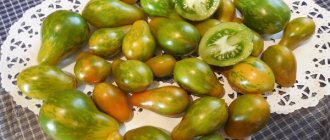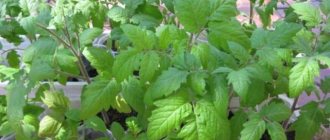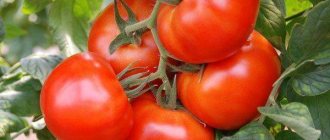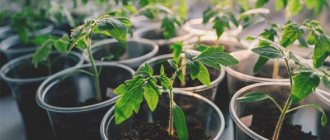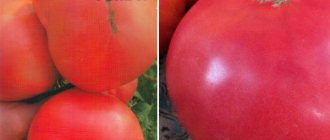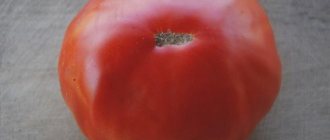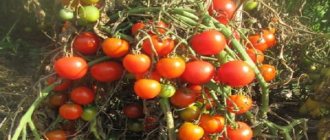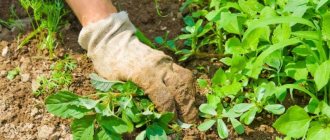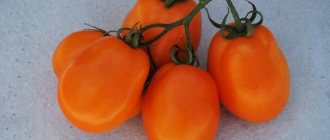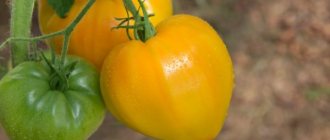This variety of Brazilian selection has proven itself well in the vastness of Russia for a long time.
Experienced gardeners do not need any special introduction. It is loved for its ease of care and abundance of large, tasty fruits. The main disadvantage is the ability to successfully grow de Barao giant only if you have a greenhouse on the site.
general characteristics
- It is considered medium-late, but, as practice shows, the ripening period is closer to late. The period from the emergence of seedlings to the ripening of the first fruits is 123-128 days.
- Super Tall: Can grow up to 270cm tall!
- Not a hybrid variety, Brazilian selection.
- Indeterminate. It actively grows in height and to the sides, so it will require mandatory stepsoning. And also - pinching the tops of the bushes in the last days of August, so that the plant does not waste energy on the formation of new flowers and fruits, but feeds well the already established ones, then they will have time to ripen before the onset of cold weather.
- Requires mandatory garter throughout the growing season.
- In temperate latitudes of the middle zone it is suitable only for greenhouse cultivation. It makes sense to plant in open ground only in the very south of the Russian Federation.
- The leaves are green, the usual shape for tomatoes.
- The fruits are large, elongated, plum-shaped, some have a funny “nose” at the tip. Not very large - up to 350 g each.
- The texture is dense, meaty, juicy, very tasty.
- At the same time, in general, the yield of the variety is quite high: up to 11 fruits are formed in each cluster with proper care. From 1 square meter of tomato plantation you can harvest about 20-22 kg of tomatoes.
- The fruits are suitable for pickling, fresh consumption, and making juices.
Tomato de barao giant
Let's start with a description of the variety, the appearance of the bushes and fruits.
"De Barao Giant" refers to a late-ripening variety. The ripening time is more than four months. This variety got its name for its spreading powerful bushes, reaching a height of three meters or more.
The leaves are dark green in color and quite large. Fruit clusters contain from six to eleven tomatoes. The first ovaries are formed after the appearance of the 9th leaf.
The fruits are egg-shaped and bright red. Compared to the regular variety, its fruits are larger in size. The weight of each fruit is from 150 g to 350 g. But gardeners grew this fruit, which weighed more than a kilogram. The taste combines both sourness and sweetness. The pulp of the fruit is fleshy and juicy. They are incredibly tasty fresh!
Next, let's look at what advantages this variety has and what its disadvantages are.
Advantages
"De Barao Giant" has a lot of advantages:
- Gives a good harvest, even under uncomfortable conditions;
- Marketable appearance of the fruit;
- The application is universal: the fruits are suitable for any processing, including whole-fruit canning;
- Good transportability over long distances due to its pulp structure;
- Resistance to diseases that are typical for nightshades.
But this variety of tomato also has its drawbacks.
:
- Instability to the Colorado potato beetle and other pests;
- Due to the late ripening period, they are not adapted to fruiting in the ground; they are grown only in greenhouses or hotbeds;
- Compliance with the requirement of a high ceiling in the greenhouse so that the plant does not bend, but is placed at full height;
- A garter and timely stepsoning are needed.
Next, we will consider the process of growing this variety of large tomatoes with proper care.
Like many varieties of tomatoes, “De Barao” is grown through seedlings with further planting in a greenhouse. Note that these tomatoes do not degenerate. This means that you can prepare the seeds yourself, renewing them after three years.
Below we will tell you how to properly prepare seeds for planting in order to increase their germination.
- The first thing to do is soak the seeds in thawed, lukewarm water. The floating seeds must be removed, and the heavy ones left at the bottom for planting.
- The second is etching in a weak solution of manganese, which will destroy microbes.
Currently, they also use a procedure such as oxygen saturation using an aquarium compressor, which will speed up the ripening of fruits.
So, we have prepared the seeds correctly, now it’s time to sow them.
The soil for the “Giant de Barao” tomato variety should be light, and before sowing it should be fertilized with wood ash, urea, and potassium. As for containers for planting, any container will do, as long as it has drainage. The seeds are planted to a depth of two centimeters and watered. Then cover it with either glass or film and place it in a well-lit place. After five days, when the first shoots appear, the shelter is removed. Seedlings need regular watering and fertilizing with fertilizers every two weeks. When the third true leaf appears, picking is done in separate peat containers. To avoid damaging the root, take the bush with a piece of earth.
Two months after sowing, the seedlings need to be planted in a greenhouse. The soil must be warm and not dry. Tomatoes are transplanted into holes where a handful of humus is thrown. Given the tall growth and spreading nature of the bush, no more than three bushes are planted per square of area.
They care for “Giant de Barao” tomatoes like all varieties of greenhouse tomatoes. What is needed to organize good care for these plants? And this:
- Tie up the bush in a timely manner;
- Irrigate plants. Mulch the soil with straw or sawdust to retain moisture;
- Weed and loosen in a timely manner;
- Once every two weeks, fertilize with either mineral or organic fertilizers in turn;
- Carry out stepsoning, forming a bush into one or two stems, while removing leaves and stepsons throughout the fruiting period;
- Carry out systematic ventilation of the greenhouse;
- Despite the fact that the “Giant de Barao” variety has good immunity to late blight, powdery mildew, and blossom end rot, prevention from other diseases consists of maintaining crop rotation once every 3 years.
And finally, let's look at the types of uses of this tomato variety.
The main feature of these tomatoes is that they are universal in use. They can be eaten raw or in salads. They are good when marinated. Used for making soups, pizza, Greek salad, soups. Due to low juiciness, good juice, ketchup, and pastes cannot be obtained.
Advantages and disadvantages
- The fruit sets well even with not very careful care.
- The harvest is perfectly stored and transported, maintaining its presentation.
- The variety bears fruit for a very long time - until the onset of frost in October.
- With proper agricultural technology, diseases are extremely rare.
- Mid-late or even late ripening. If fruit ripening is delayed, there is a risk of contracting late blight, which begins to develop with decreasing temperatures and increasing air humidity.
- Quite a high yield of the bush.
- The ability to grow this variety only in greenhouse conditions.
- Small fruit size.
Reviews
Katerina
A new variety that I tried is “De Barao Giant”. Last year and this year he pleased with large red fruits. The plants grow tall, so you need to prepare trellises in advance. I also make sure to pinch the tops, then the tomatoes turn out larger. The seeds germinate well and do not require special care. It is enough not to skip watering, replant, process and tie up several times.
Ksusha
The tomatoes from the De Barao Giant variety are not very large, but sweet. There are many varieties of this variety, but these ones turn out to be larger than the others. The bushes pleased me with their productivity. On each one there were 6-7 clusters, on each cluster there were 6-7 rather large fruits. The weight of one is 130 - 250 g. Ideal for preservation. I was satisfied with the variety, I recommend it to everyone!
Svetlana208
I have been planting these tomatoes for three years now. During this time they never upset me. There was always a wonderful harvest, tasty and juicy tomatoes. But the plants are quite tall, so I have to make a support; I use metal reinforcement. Tomatoes are also resistant to diseases, which is very important. They bear fruit until the first frost. The results are incredibly tasty salads and preserves. If you haven’t tried these tomatoes yet, be sure to add to your collection of varieties, you won’t regret it.
Growing seedlings
- Seeds are sown 60-65 days before planting in the greenhouse.
- They should be soaked for at least a couple of hours before sowing. Floated, darkened seeds are not suitable for sowing. After this, it’s a good idea to try to awaken them with a “contrast shower”: first pour hot water (about +50 degrees), then cold. Repeat this 3-4 times, then sow. As an option, you can use biostimulants - “NV-101”, “Epin”, “Zircon”.
- In order not to further injure the root system with transplants, you can sow the seeds directly into separate seedling cups (peat cups are perfect).
- One of the best soil options is from beds where green manure grew last season - mustard, peas, beans, beans, lupine. 1/3 of coarse sand should be added to it. It is good to add to the mixture 1 glass of wood ash, 15 grams of potassium chloride and nitrogen mineral fertilizer (for example, “Urea”)
- Before sowing, the soil also needs to be treated - disinfected with “Maxim”, a pink solution of potassium permanganate. You can buy Furacilin (an antifungal drug intended for treating people) at the pharmacy, crush 1 tablet, dissolve in 1 liter of water and moisten the soil generously.
- Before seedlings appear, crops should be kept covered with glass or transparent plastic film to create a greenhouse effect. Temperature for seed germination is +20-23 degrees. At this time, it is important to monitor soil moisture. The soil should not dry out, but water should not stand in it either, otherwise the seeds will “suffocate” in it.
- The care for growing seedlings is usual: periodic watering without flooding the soil, loosening the soil, applying fertilizing. The first is after the appearance of the first true leaf. It is best to apply complex mineral fertilizers (without the dominant component of nitrogen!). Doses are 2 times less than those recommended in the instructions. Before fertilizing, it is important to water the seedlings generously: chemical compounds are well absorbed by the roots only when dissolved in water.
Folk fertilizer for tomato seedlings
Eggshells from 4-5 chicken eggs should be placed in a 3-liter jar, filled with water and tightly closed with a lid. The jar should be in the dark. After 3 days, the infusion will become cloudy, it is ready for use. Fertilizing is very effective: it gives an excellent impetus to the rapid development and growth of seedlings. But you need to be prepared for the cost: when watering, an extremely unpleasant smell will spread throughout the apartment, characteristic of that released during the decomposition of hydrogen sulfide.
- Tomato seedlings need a lot of sunlight; they should be grown on the most illuminated windowsill. On the hottest days, shade from direct burning sun rays.
- Before planting in the greenhouse, it is better to harden the seedlings, i.e. accustom to open air and lower temperatures, especially at night. To do this, the plants are taken out into the fresh air, first for a couple of hours, then left on the balcony or in the yard longer. And finally, they leave us to spend the night. The entire hardening process can take up to 2 weeks.
Advice: if the seedlings have outgrown
If the weather stays cool outside for a long time in the second half of spring, and night frosts recur periodically, tomato seedlings cannot be planted in a greenhouse. But on the windowsill it begins to outgrow, stretch, and the trunks of the seedlings become bent. This upsets the seedling owners. In fact, there is nothing wrong with this. And even vice versa.
Additional roots begin to form on overgrown stems. It is important to bury them when planting in open ground. Then the root system of the bush will be more voluminous, more powerful, and the bush will be able to receive additional nutrition thanks to it. Which will undoubtedly have a positive effect on the harvest.
Are there any disadvantages?
All varieties have their strengths and weaknesses. Before growing this or that tomato, you should study them:
- Of course, you can plant several bushes in open ground, but a larger harvest requires a greenhouse. Moreover, the greenhouse should be high, even better if the greenhouse is heated.
- Most of the varieties based on the “de barao” variety of tomatoes are famous for their very juicy and tender pulp, which is not suitable for canning in its entirety. They are used to make sauces and tomato paste, since the amount of seeds in a tomato is minimal.
- Neighborhood with an indeterminate variety can harm other tomatoes. Large, spreading vines will simply block the light for other plants in the greenhouse. Plant tall varieties on the less lit side or use a separate greenhouse for them.
- Plants require more space when planted.
- Among the disadvantages of this variety, many note the presence of a hard skin around the stalk. The top of the tomato remains green for a long time and may become rough and cracked.
Caring for tomatoes in a greenhouse
- Tomatoes need to be transplanted into the greenhouse when daytime temperatures reach +15-18 degrees. and the threat of night return frosts has passed.
- The beds in the greenhouse can be prepared in the fall by adding horse manure (a bucket per 1 sq.m.). Or - complex mineral fertilizer (application doses - according to the instructions attached to it). Tomatoes love to grow on a “warm bed” of manure. Unrotted manure (you can use not only horse manure, but also goat and cow manure) or undiluted bird droppings is placed at the bottom of the planting holes. It is only important to lay the heating mat at a sufficient depth (at least 35-40 cm) so that the roots do not immediately reach it and do not get burned. An excellent filler for planting holes is 4-year-old compost.
- Scheme of planting tomato seedlings 50X50. Practice shows that the harvest is better if per 1 sq. grow no more than 3-4 bushes per meter.
- After a week, the planted tomatoes should be tied up. And do this regularly as they grow.
- It is most productive to grow this variety of tomatoes with 2 trunks. The very first stepson should be left, the rest should be cut off. The leaves should also be torn off: all the leaves up to the first fruit cluster, and every other one above it. When all the fruits have filled, it is better to destroy all the leaves on the bushes. This way there will be much less risk of catching late blight, and it will also contribute to better and faster ripening of the fruit.
- If the beds have been thoroughly prepared, it is important not to overdo it with the application of nitrogen fertilizers. Organic matter is also rich in nitrogen, including mullein infusion, beloved by all gardeners. If a plant is overfed with nitrogen, it will drive away foliage to the detriment of flowering and ripening of fruits. In addition, it will become especially susceptible to diseases and pests.
- In addition to fertilizing with mineral and organic fertilizers, foliar fertilizing with an aqueous solution of boric acid (1 g/1 l) will be useful for tomatoes. Thanks to this, more ovaries are formed on the bushes, the fruits form faster and better. Spraying begins at the moment the first flower clusters form and is repeated throughout the season every 7-10 days.
Fighting late blight
All gardeners know what an insidious disease this is. It affects already ripening fruits and ovaries at the very moment when we are waiting for the harvest to ripen. The reasons are cold and damp. Late blight is actually a fungus called Phytophthora infestans. Fungal spores are even found on tomato seeds. For many regions, the disease has become a real natural disaster.
Neither agricultural technology nor chemistry can completely rid your garden of this pest. Other crops, such as potatoes, are also susceptible to late blight. The most effective method of struggle is an integrated approach. To stop the spread of the disease throughout the entire area, use tomatoes that are resistant to the disease. Such a variety is, for example, the pink tomato. Reviews of gardeners satisfied with the variety directly indicate this.
Additionally, high plant growth helps protect the crop. The fruits are high off the ground and are not in contact with spores. Mulching the soil after watering, ventilating and tying up plants can further reduce the risk of disease. Trimming excess leaves and pinching out stepsons is mandatory, since a greenhouse thickened with greenery will be damp.
Tip: if the fruits take too long to ripen
Spraying the bushes with an aqueous infusion of iodine will help speed up the process. 4 drops of the drug are diluted in 3-4 liters of warm water. Each bush should get at least 2 tablespoons.
- To prevent late blight, you can spray the bushes with an aqueous solution of whey (1 liter of whey per 12-liter bucket of water). It will not be worse if treated with serum undiluted in water. Spraying should be repeated until the end of the growing season at intervals of 10-14 days. Dusting with wood ash (once every 10-14 days) also helps protect plants from late blight. You can sprinkle it not only on the “legs” of the bush, but on its entirety.
- Tomatoes like fairly abundant watering, but not excessive. Under no circumstances should you water in the middle of a hot day. It’s better in the evening, or at any time of the day if the weather is cloudy. After the procedure, it is important to open the greenhouse wide and ventilate thoroughly, otherwise there is a high risk of developing infectious diseases in conditions of high humidity.
Tip: if the fruits crack
This problem often occurs when growing tomatoes with large fruits and delicate skin. It is primarily associated with one-time excessive watering. Tomatoes are able to absorb large volumes of water quite quickly. Many gardeners simply put a hose in the greenhouse, turn on the water and go about their business. And the “flood” begins in the tomato beds. Tomato bushes absorb a huge amount of moisture at a time, as a result of which the shell of the fruit, and sometimes even the stems, cannot withstand it and form so-called “moisture holes”.
This risk especially exists on heavy clay soils that have not been improved with sand and other loosening materials. Excellent yield on poorly permeable soils:
- raised beds;
- drainage under plantings.
And, of course, each bush should be given as much water as it can absorb without damaging the harvest.
Mistakes of summer residents
Despite good disease resistance and ease of care, not all summer residents manage to grow strong bushes with a good and tasty harvest due to several mistakes:
the use of expired or disease-infected seeds, as a result, crops germinate poorly, and seedlings grow slowly, are massively damaged by blackleg and die; too late or early picking of sprouts: in the first case, from lack of space and moisture, the plants turn yellow and dry out, in the second, they quickly wither, because
very weak and did not have time to grow roots and foliage; planting in the garden without hardening - as a result, the tomatoes burn in the sun or freeze from the cold at night; thickening of plantings - due to lack of space, fertilizers, plants develop slowly, bloom weakly and wither; lack of pinching leads to uncontrolled growth of greenery and poor formation of ovaries; on a neglected plot where weeding, loosening and timely removal of weeds are not carried out, various pests and diseases appear, so it is very important to keep the plot clean; non-compliance with the watering regime - the bushes and fruits rot due to excessive moisture; if there is a lack of moisture, they grow poorly and produce a small harvest of vegetables; An excess of fertilizers in the soil, especially nitrogen, stimulates the growth of green mass and inhibits flowering and fruiting.

